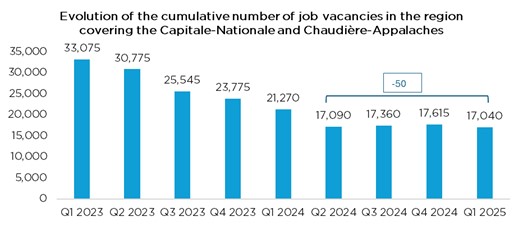Highlights – First quarter of 2025

Data visualization
 Sources: Statistics Canada, Table 14-10-0398-01, and Québec International
Sources: Statistics Canada, Table 14-10-0398-01, and Québec International

Analysis
Asymmetrical evolution on either shore
According to the Job Vacancy and Wage Survey (JVWS) conducted by Statistics Canada, the number of vacant positions in the combined regions of the Capitale-Nationale and Chaudière-Appalaches settled at 17,040 during the first quarter of 2025, marking a slight decline of 3.3% compared to the previous quarter. This is the fourth consecutive quarter showing relative stability in the region, breaking with the downward trend that started in the first quarter of 2022 (identified at 100% in the graph below), when there were 39,790 vacant positions. However, between the fourth quarter of 2024 and the first quarter of 2025, the two regions faced opposite dynamics: the number of vacant positions dropped by 8.1% in the Capitale-Nationale region (-1,000), but increased by 8.1% in Chaudière-Appalaches (+425).
Number of vacant positions as a proportion of the peak registered in the first quarter of 2022 for the combined regions of the Capitale-Nationale and Chaudière-Appalaches
 Sources: Statistics Canada, Table 14-10-0398-01, and Québec International.
Sources: Statistics Canada, Table 14-10-0398-01, and Québec International.
On an annual basis, however, the trend remains down. Indeed, compared to the first quarter of 2024, the number of vacant positions dropped by 25.1% in the Chaudière-Appalaches region and by 6.9% in the Chaudière-Appalaches region. This drop is part of a larger declining trend across the province of Quebec (-19.3%) and Canada (-18.1%). When using an integrated approach to look at both administrative regions—whose economies are highly interconnected—, this evolution indicates stagnation in the labour market.
Overall demand: Stability despite variations
The overall labour demand, which includes vacant positions and payroll jobs, with the exception of self-employed workers, also evolved differently in each region, although the difference was not as sharp. Between the fourth quarter of 2024 and the first quarter of 2025, overall demand grew by 3.0% in the Capitale-Nationale region, a higher increase than in Chaudière-Appalaches (+1.0%). On an annual basis (Q1 2024–Q1 2025), total demand in both regions grew by 2.3%, reaching 628,505.
Compensation: Sustained wage growth
Despite the overall downturn in excess work demand, wages continued to increase. Based on seasonally adjusted data by Statistics Canada, the average hourly wage increased by 3.1% in the Capitale-Nationale region, going from $27.65 to $28.50 between the first quarters of 2024 and 2025. In Chaudière-Appalaches, this growth was 7.1%, with the average hourly wage going from $25.90 to $27.75.
Rosalie Forgues
Economist
Québec International




